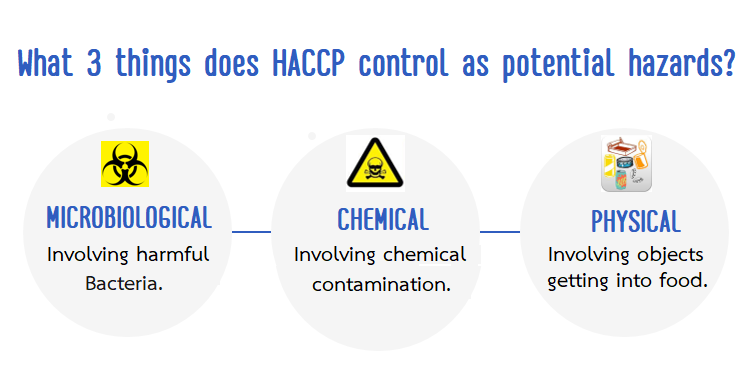News and Activities

What is HACCP ?
What is HACCP ?

Hazard Analysis Cricital Control Points (HACCP) is a system which provides the framework for monitoring the total food system, from harvesting to consumption, to reduce the risk of foodborne illness. The system is designed to identify and control potential problems before they occur. In its Model Food Code, the Food and Drug Administration has recommended the HACCP system “because it is a system of preventive controls that is the most effective and efficient way to assure that food products are safe ” (1999 FDA Model Food Code) . The application of HACCP is based on technical and scientific principles that assure safe food.

What 3 things does HACCP control as potential hazards?
1. microbiological - involving harmful bacteria.
2. chemical - involving chemical contamination.
3. physical - involving objects getting into food.
The 7 principles of HACCP
1. Conduct a hazard analysis.
Plan to determine the food safety hazards and identify the preventive measures the plan can apply to control these hazards. A food safety hazard is any biological, chemical, or physical property that may cause a food to be unsafe for human consumption.
2. Identify critical control points.
A critical control point (CCP) is a point, step, or procedure in a food manufacturing process at which control can be applied and, as a result, a food safety hazard can be prevented, eliminated, or reduced to an acceptable level.
3. Establish critical limits for each critical control point.
A critical limit is the maximum or minimum value to which a physical, biological, or chemical hazard must be controlled at a critical control point to prevent, eliminate, or reduce that hazard to an acceptable level.
4. Establish critical control point monitoring requirements.
Monitoring activities are necessary to ensure that the process is under control at each critical control point. In the United States, the FSIS requires that each monitoring procedure and its frequency be listed in the HACCP plan.
5. Establish corrective actions.
These are actions to be taken when monitoring indicates a deviation from an established critical limit. The final rule requires a plant's HACCP plan to identify the corrective actions to be taken if a critical limit is not met. Corrective actions are intended to ensure that no product is injurious to health or otherwise adulterated as a result if the deviation enters commerce.
6. Establish procedures for ensuring the HACCP system is working as intended.
Validation ensures that the plans do what they were designed to do; that is, they are successful in ensuring the production of a safe product. Plants will be required to validate their own HACCP plans. FSIS will not approve HACCP plans in advance, but will review them for conformance with the final rule.
Verification ensures the HACCP plan is adequate, that is, working as intended. Verification procedures may include such activities as review of HACCP plans, CCP records, critical limits and microbial sampling and analysis. FSIS is requiring that the HACCP plan include verification tasks to be performed by plant personnel. Verification tasks would also be performed by FSIS inspectors. Both FSIS and industry will undertake microbial testing as one of several verification activities.
Verification also includes 'validation' – the process of finding evidence for the accuracy of the HACCP system (e.g. scientific evidence for critical limitations).
7. Establish record keeping procedures.
The HACCP regulation requires that all plants maintain certain documents, including its hazard analysis and written HACCP plan, and records documenting the monitoring of critical control points, critical limits, verification activities, and the handling of processing deviations. Implementation involves monitoring, verifying, and validating of the daily work that is compliant with regulatory requirements in all stages all the time. The differences among those three types of work are given by Saskatchewan Agriculture and Food.
Benefits of using a HACCP system
1. Saves your business money in the long run.
2. Avoids you poisoning your customers
3. Food safety standards increase
4. Ensure you are compliant with the law
5. Food quality standards increase
6. Organises your process to produce safe food
7. Organises your staff promoting teamwork and efficiency
8. Due diligence defence incourt
If you are interested in renting high-quality CHOD Factory & Warehouse that have complete functions as well as heat protection systems , Please contact us.
Reference : Tomco
